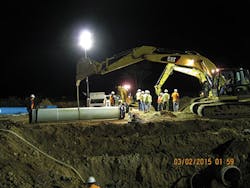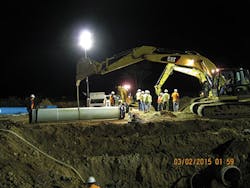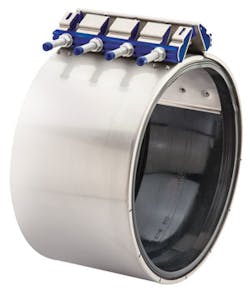Keeping Workers Safe During Nighttime Repairs
By Doug Riseden
Working at night on pipe repairs is always more difficult than during the day. Workers are usually tired, having already worked a full day, and visibility is greatly reduced due to shadows, darkness and poor lighting at the work site. Add to that drivers who are also tired and perhaps driving faster than usual due to reduced traffic, and you have the makings of a high-risk situation. Your employees are your most valuable asset, so every precaution should be taken to ensure that they come home safely every day.
Krausz designs and manufactures a variety of repair couplings that are quick and easy to install and are extremely useful for nighttime conditions. The HYMAX VERSA coupling can attach to two pipes of differing diameters and materials, which comes in handy when the exact material of the pipe or its diameter is unknown in advance.
The coupling also features top-facing bolts, which are simple to tighten and drastically cut installers' repair time. Further, the product features a stab-on design and does not need to be disassembled (there is nothing more aggravating for an operator than losing a bolt in a water-filled ditch at night). Another unique feature is its MAG dry anti-galling process that prevents galling, enables repeated bolt tightening and eliminates the need to grease the bolts, preventing dust and dirt buildup.
Here are six recommendations to ensure that your nighttime workers stay safe and get the job done effectively.
1. Move Carefully and Deliberately on the Work Site
Many times, workers will want to finish the job quickly and skip some steps. This is understandable, but it's important to remind them to slow down and work more cautiously than they do during the day. Even if they are very familiar with performing certain repairs, dark areas and shadows can hinder their perception of risk.
Planning and communication are crucial during nighttime operations. Before the job starts, supervisors should have a brief meeting to ensure that all team members understand what will take place at the work site, what their roles will be and where they will be located throughout the night. Plan your work and work your plan.
Make sure everything is completed with a focus on safety. This includes wearing reflective clothing in accordance with the law and using a trench box or shoring to ensure that a trench doesn't collapse while workers are inside. There are many who never use a trench box because it hinders some repairs; at night however, the use of these boxes and shoring is even more critical. Make trench boxes a normal part of every excavation, and never put speed ahead of safety.
2. Have the Right Repair Products on Hand for Every Possibility
Always make sure that you have repair products on hand for every situation. There is nothing worse than not having the right parts during an emergency repair. Poor planning results in the job taking longer to complete, delays in returning water service to normal, and disgruntled customers.
3. Keep a Close Eye on the Crew
Supervisors should keep a close eye on workers who might be tired from working a full day and prone to making mistakes. Likewise, supervisors should patrol their work area and offer food and drink on a regular basis. Flaggers, in particular, should be checked, as they play a critical role in ensuring that nighttime operations are safe.
Crews want to make repairs and then get some rest before having to get up and do it all over again. A lack of rest or sleep accumulates over time, so it's important to ensure that crews are not exhausted to the point that they are unable to perform. Provide them with the proper tools and repair parts to get the job done.
4. Keep the Work Area Well Lit and Clear
In the interest of saving time, workers will sometimes use the lights of the backhoe to perform a job without auxiliary lighting and a generator. However, these lights will not supply enough illumination for the work site, which can compromise safety.
Use floodlights to illuminate any equipment crossings and other areas where crewmembers will be working. Flaggers, in particular, should be well lit to ensure their own safety and the safety of the work zone. If drivers can't see the flagger, his or her ability to slow down, divert or stop traffic is hindered.
Floodlights can also blind drivers entering a work zone. Once lighting is set, a worker should drive through the area to observe the lights' positioning and make adjustments as necessary. The use of self-righting work lights is also ideal, in that they do not shine in motorists' eyes. In addition, keep the work area clear of obstacles, tools and equipment.
The use of rotating or flashing amber lights on service vehicles is necessary and required by law in most states. However, these lights can be very bright and could blind drivers who are traveling the roadways. Wherever possible, direct these lights so that drivers can see properly as they pass through, ensuring worker safety.
5. Manage Traffic
If possible, close the roadway where the repairs are taking place and direct traffic away. If you can't close the roadway, position warning signs or lights in a way that will give motorists more time to react and slow down before reaching the work area. Ensure that your signs are clean and have good reflectivity.
Make the work zone as large as possible to give employees more of a buffer and to keep them safe. After the repair is completed and the roadway reopened, conduct several drive-throughs to ensure that the road is clear and the repair is safe for public use.
6. Notify the Public
Make every effort to contact law enforcement, fire and rescue services, emergency dispatch centers, and the general public about the nighttime operation. Further, notify the above organizations and local radio and television stations in advance by sending a concise email and following up by phone. Include information about where the repair is taking place, why it's happening and any roads that will be closed off. These agencies and media outlets will appreciate the information and keep the community aware of the repair. WW
About the Author: Doug Riseden is the technical support manager for Krausz USA and has worked in the public utility field for over 20 years. His extensive experience with water and wastewater repairs and operations includes working for municipalities and private contractors and providing water services to the NATO-led security mission in Afghanistan as part of Operation Enduring Freedom.
More WaterWorld Current Issue Articles
More WaterWorld Archives Issue Articles


